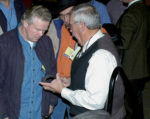Advertise Follow Us
Articles Tagged with ''Radiographs''
What we used to understand about navicular disease has changed a great deal. Still, veterinarian David Ramey is optimistic about how we treat what we thought we knew
Read More
Hoof Care
Precise Measurements Emphasize Biomechanics For Balance, Breakover
Proper management includes critical measurements that allow a farrier to position the breakover point to meet the functional needs of the horse throughout the shoeing cycle
Read More
Radiographs Not Just for Veterinarians
“We’re not looking for a nice outside, cosmetic appearance of the foot — we’re looking for inside health…”
Read More
Built to Work -- And to Last
Farrier Diane Greene wanted a rig that would keep her on the job and out of repair shops. After a shaky start, she's on the road again
Read More
The Earth is Not Flat
Meaning horses spend very little time moving over level ground — something Scott Lampert says you need to keep in mind while your shoeing
Read More
How Comfortable Are You With Radiography?
If you’re not working with equine veterinarians to get a look inside problem hooves, you might not be doing all you can for the horses and their owners. Here’s how to get more involved with this technology
Read More
Peeking Inside
Diagnostic imaging can give farriers an edge by looking inside the hoof, but horseshoers have to understand the ins and outs of various imaging techniques that have advanced far beyond the familiar X-ray technology.
Read More
Farriers Walk Fine Line in Dealing with Hoof Abscesses
Shoers, veterinarians, share thoughts on a touchy subject
Read More










